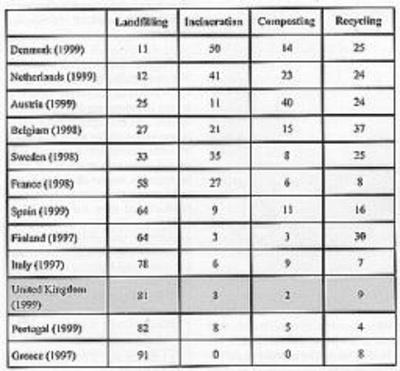A burning issue: energy from waste
Our party entered the last general election with a short-term fix on the question of energy from waste (EfW). We cannot go into the next general election still saying that we need to do more research when evidence is there. The truth is, we are divided. There are those who see this as a good local NIMBY campaign and there are those who see incineration simply as a matter of waste policy. But some of us see this technology as part of a sustainable resource policy.
The Labour Party's green group, SERA, and Greenpeace are both opposed to the incineration of municipal waste, claiming that they emit dangerous dioxins (linked to the development of cancer) and undermine the development of comprehensive waste minimisation and recycling strategies as, once built, incinerators must continually be fed with 'waste'.
We all know the hierarchy of waste policy: the higher up the hierarchy one goes. the more the value of a product is preserved. Indeed we would all agree that the best option of all is to avoid the use of a product altogether. Where many of us might disagree is over the value of recycling: it is not always the best environmental option. Similarly, many of us would not be sure of the real costs and benefits of recovering the energy content of materials. Greenpeace would like to see the hierarchy reclassified, with EfW placed on the bottom rung, alongside landfill. In contrast, I believe that the benefits of EfW are significant.
Currently, about 8% of municipal waste is incinerated with energy recovery, 9% is recycled, and 83% goes to landfill. EfW is a generic term covering a vast range of fuels and technologies. Not All technologies are equal: some are much more damaging than others.
Many existing UK incinerators burn waste directly. Some mix the burning of waste with the burning of gas, but this is not encouraged by the electricity generation regime. This is disappointing, since. when waste is burned in the presence of other fuels, combustion conditions are much more stable and cleaner. Recyclates such as glass and aluminium are sometimes recovered before combustion, sometimes afterwards.
New technologies, well known on the continent, are making their way to the UK. These include pyrolysis, where the waste is 'pressure cooked', rather than burned, releasing a synthetic gas which is then used in power generation. This leaves the vast proportion of toxic materials in the residue and is no more polluting than conventional power generation. Other systems can digest compostable materials such as kitchen waste, producing gas for power generation and clean fertiliser.
Direct incineration can generate electricity at up to 18% efficiency. Given the nature of waste, it is technically difficult to achieve higher than this without co?combustion with other fuels. Newer technologies using gas from pyrolysis or digestion can generate electricity at 25 or 30% efficiency.
This compares to some 37% efficiency for the overall national electricity generation system. The remaining heat is usually dumped to atmosphere, as it is in conventional power generation. The major advantage of EfW is that it reduces the use of fossil fuels.

Some plants recover the waste heat, supplying it to the local community and thus achieving up to 80% overall efficiency. A scheme in Sheffield, for example, supplies thousands of homes, two universities, a hospital, the council buildings, and the Ponds Forge leisure complex as well as a variety of commercial buildings. Similar schemes are in operation in Nottingham and Lerwick. Other existing EfW plants arc looking to do the same thing. For example, the SELCHP scheme in Lewisham could supply up to 30,000 south London homes with low cost heat. The only additional cost will be transporting the heat through the network. Once built, the network offers security of supply, being able to take otherwise waste heat from EfW, gas-fired power generators or renewables-fired boilers.
In addition to this type of scheme there are others taking methane from landfill to bum to generate electricity. And many industrial sites burn industrial wastes and produce both heat and power at around 80% efficiency.
But can EfW be classified as a renewable resource? There are some deep contradictions in attitudes to EfW. For example, it is difficult to see why virgin woodchip used as fuel is seen as good and treated as renewable but woodchip that has seen a useful life converted into paper or packaging and then burned is somehow 'impure' and not renewable. And why is it less acceptable to use oil in the production of plastic packaging which has a useful life first and then a second life burned in an EfW plant than to use virgin fossil fuel in a power plant? Again, why is electricity generated from landfill gas counted as renewable but not energy from waste?
The potential for EfW in meeting our energy needs is significant. Using the waste from one household could supply 10% of the electricity and heat needs of that household. EfW plants can be relatively small, serving around 50,000 households: each council area could be responsible for its own waste. This is important, for we all recognise the proximity principle (waste should be dealt with in the community that generates it).
In the right circumstances, recycling is justifiably higher up the waste hierarchy than EfW. However, there are real limits to recycling municipal waste. Materials commonly found in waste include glass, metals, compostables, paper, plastics, and small amounts of toxic materials such as batteries and electronic and electrical goods. Nobody is suggesting that glass and metals should be a fuel for incinerators, since they don't burn. They should always be removed first to reduce air emissions. Compostables too should always be composted to produce gas for combustion, since they don't bum well when wet.
But plastics should always be burned. They are made from fossil fuels and burn well. They also recycle extremely badly. There are in excess of 700 different polymers which do not process well together, and there is no good market for mixed plastic waste as a material. But given the level of fossil fuel bum elsewhere in the economy, displacing it with EfW based on plastics is a small issue.
Paper is difficult. We would all like to recycle paper. But the main savings from recycling paper is energy in processing and in reducing tree use. But as long as forest or other biocrop sources for paper and other uses are sustainably managed, why should there be a problem? It must be better to ensure that a tree gets used more than once, first as a product and then for energy? In energy terms, it is as useful to incinerate paper with energy recovery rather than recycle it. The environmental benefits of recycling paper are anyway marginal if other steps in the system are right.
Products with a toxic content electronics, batteries, paints, oils etc. will always present a problem in the waste stream. They do for incineration, and this is where most of the toxicity referred to by SERA and Greenpeace comes from. But they are a problem for landfill too, where materials leach out into groundwater. There is no simple solution, but if separated from conventional waste, they can, and should, be treated separately, and reused or recycled where possible.
Finally, there is a big difference in the environmental effects of bring collection systems for recycling compared to kerbside collection. Most of the benefits of recycling come from kerbside systems, as the benefits of recycling are eroded by the fuel used when people have to use their cars to take glass and paper to a collection point. Kerbside separation systems would also have big benefits for EfW schemes in that the product being treated or burned would be cleaner and toxic materials removed.

The fact is that recycling and EfW are broadly compatible: using the best technologies. EfW would not, in practice, reduce realistic recycling rates.
Nobody doubts that waste reduction and reuse are the preferred options for waste. The questions are the extent to which recycling is preferred and the value of EfW over landfill.
Not all EfW technologies are the same and it would be wrong from an environmental perspective to treat them in the same way. The argument that EfW produces cancer-inducing substances does not apply to all technologies. Where schemes are cleaner than conventional power generation, there are no grounds for banning them. The argument that EfW disadvantages recycling is just untrue.
But where incineration produces no energy, or where energy can be achieved at a lower resource cost from conventional generation, EfW has no benefits. However, EfW can achieve lower emissions at a higher efficiency than conventional power generation. So, where energy from waste displaces conventional fossil fuels and thus achieves significant savings in emissions or resource use, the planning system should encourage it, and incentives for cleaner power generation (as for combined heat and power or renewables) should be available.
There is plenty of evidence to show when EfW is the best practical environmental option. So we cannot go into the next General Election with a policy calling for more research or with blanket ban on EfW. Instead, decisions should depend on choosing the appropriate type of EfW as part of an integrated sustainable energy and waste strategy.
We should ban new direct combustion schemes that only produced electricity as being inefficient. Existing plants should be required to use waste heat in heat networks with the replacement of old incineration plant with best available technology at the earliest opportunity. For new schemes, smaller, pyrolysis and digestion-based plants that recover heat as well as generating electricity should be required. And, as good Liberals, the decision on the mix of approaches should always have a strong local element, bearing in mind local circumstances?
- Mark Hinnells works for the Energy Saving Trust. He is Vice Chair (Political) of the Green LibDems and is a member of the party 's Energy Policy Working Group.
